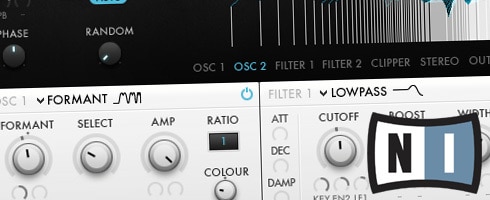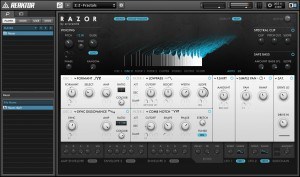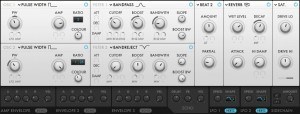Razor is an additive synthesizer built with the Native Instruments Reaktor technology. It is a Reaktor ensemble, which means that you will need to have the free REAKTOR PLAYER or REAKTOR 5.5 installed on your computer in order to use the Razor synthesizer. Razor was created as a joint effort between Native Instruments and Errorsmith, a Berlin-based music producer and a well-known Reaktor instrument designer.
What initially drew my attention to this synth was the fact that I’ve seen it labeled as sort of a new dubstep synth on several places online. Being a big dubstep fan that I am, this was more than enough reason to grab Razor and see what it can do. Also, additive synthesis was a somewhat unfamiliar concept for me, and I was interested in finding out whether I’ll be able to operate such a synth properly – being so used to working with various software/hardware VAs and FM synths.
So how does one use a Razor to create sound?
Razor’s interface is very easy to grasp, as it pretty much resembles the architecture of a standard substractive synhesizer. The interface is split into several familiar-looking sections for oscillators, filters, envelopes, LFOs, effects, etc. Anyone with basic understanding of how synthesizers work should be able to start experimenting with Razor right away, even without reading the provided manual (nevertheless, reading the manual is always a good thing, and the Razor manual is very informative and well-written).
However, even though the synth follows a classic design, each section hides a trick or two up its sleeve, making Razor a pretty unique sounding instrument. For now, let’s just say that each section uses additive synthesis to modify the sound, and this even counts for the built-in effects (the included reverb module has some rather unique properties and is capable of some really cool tricks, but more on that later).
The oscillator section features two oscillators and offers a selection of 14 unique oscillator types. Apart from the usual waveform types like Sawtooth and Pulse, you’ll some more quite exotic ones like for example Sync Classic (which features a classic oscillator sync sound) and Hoover (a great starting point for creating reese bass sounds). The amount of control depends on the selected oscillator type, as they all come with a specific set of parameters in addition to the standard volume, pitch and equalizer controls which are common for each oscillator type.
The filter section is where things start to get really interesting. Along with several different lowpass filter types, it also features a variety of less common filter types like the comb, vowel and formant filters, among others. These can be put to great use if you’re trying to create the more aggressive kind of wobbly bassline sounds used in modern Dubstep, but they also work very well in creating deep bass sounds, or lush and atmospheric soundscapes. Generally speaking, experimenting with Razor’s different filter types can be a lot of fun, and what really caught my attention was the fact that its filters always keep the sound well-defined and focused (sharp, if you will), even with quite extreme settings. No matter how crazy I went with tweaking different filter parameters and trying different filter types, the results always ended up sounding like something that could actually be used in a track, at least as sort of a cool weird sound FX or a drone. The filter section also features a 34-band vocoder which can be used to modulate the audio input signal, be it your own voice or something else.
Razor has two individual effects sections, one covering a range of various dissonance effects which can be used to create non-harmonic sounds, and the other covering more standard effects like chorus, delay, reverb, etc. The dissonance effects are a rather unique and innovative concept, based on altering the partials (building blocks of Razor’s additive synthesis engine) and thus creating some pretty unusual timbres. The six available dissonance effects can change the sound dramatically, and are a perfect tool for creating weird, out-of-this-world kind of noises.
As I’ve already mentioned, the Razor’s more conventional built-in effects like reverb and echo are actually rather unusual. Simply put, all the effects are actually synthesized in real time by Razor’s additive synthesis engine, and basically form an integral part of the synthesizer – much like its filters and oscillators (unlike the regular effects which can alter the sound only after it leaves the source). As a consequence, the reverb tails are actually pitched to the note being played, and are also devoid of the nasty metallic ringing noise often heard in software reverbs. Also, since the reverb tails are pitched, they can even be used for playing melodies with some clever use of modulation! Same goes for the echo effect which is generated using the echo envelope and can also be modulated in interesting ways.
Modulation is key
Speaking of modulation, most of the parameters in each section can be connected to a variety of different modulation sources, and defining desired modulation settings is a quick and easy task. Instead of using a modulation matrix, a selector slot shown right below each paramater enables the user to quckly apply and edit modulation settings on the go. To get the idea of what can be achieved with Razor’s powerful modulation scheme, I suggest browsing through the 350 included presets and tweaking the pitch/mod wheels on your MIDI controller while trying different sounds. I’ve literally spent more than one hour right after installing Razor, only trying out different presets and tweaking those two wheels as my jaw approached the floor more and more. In all seriousness, some of the included presets are quite astonishing and they show how proper use of modulation can turn already unique sounding timbres into amazing soundscapes.
Double rainbow! What does it mean?
Apart from the presets, another thing that kept me glued to the seat for a good one hour right after installing Razor is the big and fancy spectrum display shown on top of the interface. We often say how musical instruments and effects should be operated using our ears and not our eyes, but watching a sound evolve in glorious 3D right in front of your eyes as you play is simply captivating (take a peak at the demo video below and you’ll see what I mean). Of course, the display is not there just for the OMG double rainbow! effect, as it actually shows the precise representation of a sound’s harmonic content in each synthesis stage – a great means for creating sounds that will fit easer in a particular mix.
More features
Another feature worth noting is the Safe Bass generator which is used to add more spectral content to the fundamental frequency. It’s there to make sure that bass sounds remain musical even after some serious abuse, and is basically a great alternative to layering your synthesized sounds with sub bass outside the synth. Of course, the Safe Bass can be turned down, or completely turned off, if your intention is making sounds that don’t really need a fundamental frequency (drones, sound effects, etc.).
Razor also features a saturation module, and a Spectral Clip unit which limits the frequency spectrum in a manner somewhat similar to a LP filter (pictured above).
So you’re saying this thing is perfect?
Well I must say that I’m not a big fan of the Reaktor ensemble format because for those us who are using Reaktor Player it means that we won’t be able to save our own patches inside Razor. Of course, all the settings will be saved in your DAW’s project file, but this way of working is somewhat less flexible (note that this issue doesn’t apply to owners of Reaktor). On the other hand, both Reaktor and Reaktor Player now include full 64-bit support both for Windows and Mac OS X systems, which is a big plus.
Razor takes a few seconds to load on my system, but it’s nothing too drastic and I quickly got used to this. Also, the CPU load can go high at times, but this is understandable and quite common with modern software synthesizers.
Final thoughts
Razor is a great sounding virtual synthesizer and thanks to its affordable price of $79, the choice of whether or not you should get it only depends on your need for such a synth. For people creating bass-driven music like Grime, Dubstep and DnB, as well as those who are into discovering new methods of synthesis and creating unusual sounds, this is definitely an instrument worth getting.
Razor can sound both dirty and aggressive, as well as deep and lush, and even when pushed to the extremes it still preserves the right amount of impact and and clarity on the output, which is a quality I’ve rarely found in synths. It is a very powerful sound design tool, and fun to use both for those experienced with synthesizers and the ones who are making their first steps into the amazing world of sound synthesis. And for the non-tweakers among us, the included 350 professionally designed presets will provide more than plenty of high quality music-making material. The only two minuses in my opinion are the Reaktor format and somewhat longer loading times, but these are just minor flaws when compared to the great sound and features offered by Razor.
Video Demo
Check out the NI Razor demo video:
Features
Main features of NI Razor:
- Additive synthesis engine
- Oscillators – 14 unique oscillator types
- Creative filters – variable slopes and boosts
- Dissonance – from modulating single partials to compressing the whole sound
- Reverb per-partial – the reverb tail follows pitch
- Partial panning – pan parts of the frequency spectrum separately
- Complex formants – as filters and oscillators
- Echo steps – create evolving echoes
- Vocoder – an exceptional 34-band vocoder
- Safe Bass
- Spectral Clip
- Saturation
- Presets – 350 carefully designed and instantly usable sounds
Links
Try/Buy NI Razor: click here
Download Reaktor Player: click here
Native Instruments Website: click here






2 Comments
xenosapien213
onholy sh*t, this looks/sounds awesome… but I´m nowhere nearly as advanced/experienced enough (yet) to use anything but the (excellent) free VSTi´s… but maybe one day… and then I´ll gladly dish out those 80 bucks. thanks for the cool review!